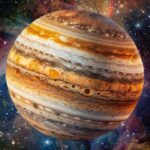
📷 Image Credits: Earth.com
The Sun, our nearest star, is a tempestuous celestial body capable of awe-inspiring displays of power. In May 2024, a hyperactive sunspot region, AR3664, unleashed a solar storm that graced our skies with vibrant auroras. But this was just the beginning of its fiery performance.
Over the weekend of May 10-12, 2024, Earth was swept by the most intense solar storm in over two decades. This celestial event triggered a geomagnetic storm, painting the night sky with breathtaking auroras at latitudes far lower than usual. The culprit behind this dazzling display was the active sunspot region AR3664. As it rotated away from Earth’s view around May 14th, it unleashed an X8.79-class solar flare, the strongest of its kind at the time, causing significant radio blackouts on Earth.
However, this was merely a prelude to even greater solar fireworks. Enter the Solar Orbiter, a spacecraft jointly led by the European Space Agency (ESA). Positioned on the far side of the Sun, Solar Orbiter offers a unique vantage point for observing solar activity that remains hidden from Earth’s view. On May 20th, the spacecraft’s X-ray instrument, STIX, detected an astonishing X12-class solar flare erupting from AR3664. “This makes it the strongest flare yet of the current solar cycle, and in the top ten flares since 1996,” remarked ESA research fellow Laura Hayes.
X-class flares represent the most powerful category of solar flares. The higher the number following the “X,” the more intense the flare. In this case, the X12-class flare from AR3664 signified an extraordinary solar event. Most solar observatories focus on the side of the Sun facing Earth. However, Solar Orbiter’s unique trajectory allows it to observe the Sun’s far side for extended periods. This, combined with data from other missions observing the Sun from Earth’s perspective, provides scientists with an unprecedented 360-degree view of our star.
“Solar Orbiter’s position, in combination with other missions watching the Sun from Earth’s side, gives us a 360-degree view of the Sun for an extended period of time,” explained Daniel Müller, Solar Orbiter Project Scientist at ESA. “This will only happen three more times in the future of Solar Orbiter, so we are in a unique situation to observe active regions on the far side that will then rotate into Earth’s view.”
Following the May 20th flare, Solar Orbiter’s Energetic Particle Detector (EPD) recorded a surge in ions and electrons moving at incredible speeds. This solar outburst also caused memory errors in the computers onboard the BepiColombo and Mars Express missions, highlighting the far-reaching effects of solar activity.
Solar Orbiter’s Metis coronagraph captured the Sun ejecting a coronal mass ejection (CME), a massive bubble of plasma traveling at speeds of up to 3000 km/s. This CME caused significant fluctuations in the magnetic field measured at the spacecraft and was even visible from Earth through the ESA/NASA SOHO mission.
The comprehensive data collected by Solar Orbiter, Mars Express, and BepiColombo revealed that AR3664 remained highly active even after rotating out of Earth’s sight. This served as a valuable warning for when the region returned to Earth’s view. On May 27th, AR3664 unleashed another outburst, spewing powerful radiation and particle bursts. While not directly aimed at Earth, this event caused a strong radio blackout over North America.
“If this flare and coronal mass ejection had been directed towards Earth, it would have caused another major geomagnetic storm for sure,” noted Daniel Müller.
As recently as June 11th, Solar Orbiter witnessed yet another X-class solar flare from AR3664 on the far side of the Sun.
Understanding the behavior of active regions like AR3664 throughout their entire lifetime is crucial for improving space weather forecasts. ESA’s Vigil mission, slated to launch in the future, will continuously monitor the Sun’s left side, providing near real-time data on potentially hazardous solar activity before it becomes visible from Earth.
“Adding Vigil’s data to our space weather services can give us forecasts up to 4–5 days earlier for certain space weather effects and provides more detail than ever before,” said Giuseppe Mandorlo, Vigil Project Manager at ESA. “Such early warnings give astronauts time to take shelter, and operators of satellites, power grids, and telecommunication systems time to take protective measures.”
The Sun’s dynamic nature continues to captivate scientists and space enthusiasts alike. With missions like Solar Orbiter and the upcoming Vigil, we are steadily advancing our understanding of space weather and its potential impacts on our technology-dependent world. The Sun’s story is far from over, and we are eager to witness the next chapter in this celestial saga.
Like what you read? Subscribe to our newsletter for engaging articles, exclusive content, and the latest updates.
Check us out on EarthSnap, a free app brought to you by Eric Ralls and Earth.com.







